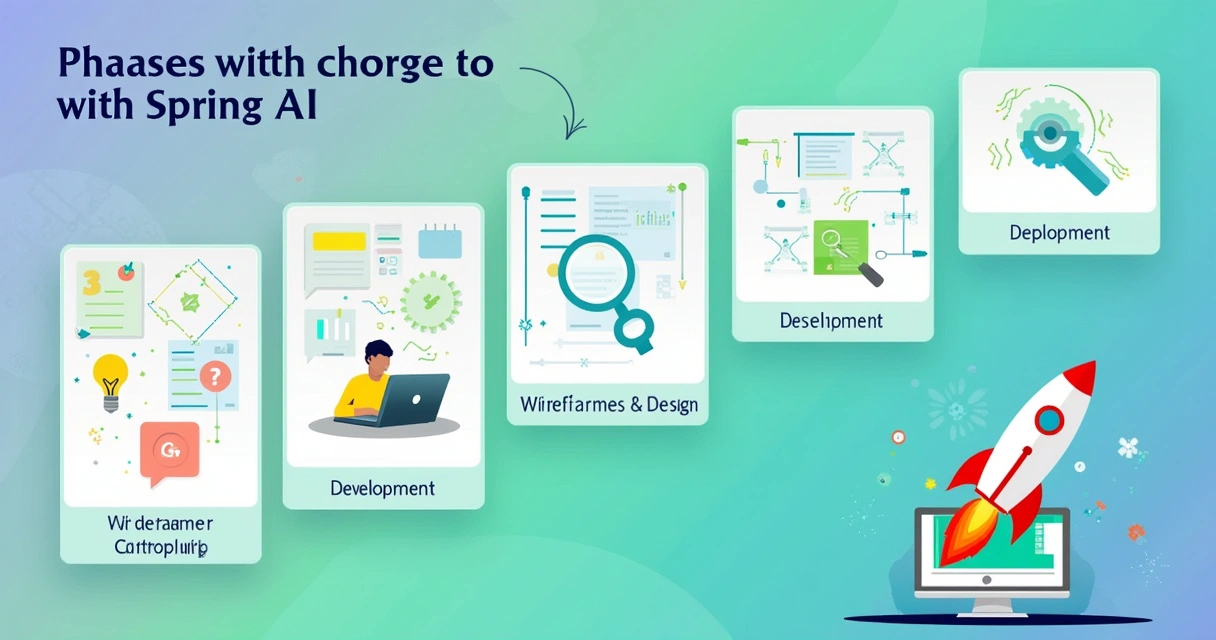
Supercharge Your Java Apps with Spring AI: A Developer’s Guide to Smarter Applications
Integrating AI technology with Spring can transform how you build applications. Imagine creating smart features like chatbots that learn from conversations! Using tools like Java and Spring Boot, you can make this happen. For example, you can connect to services such as OpenAI, which offers amazing capabilities for text generation. It’s crucial to handle errors effectively when working with APIs. This is where resources, like the OpenAI error codes guide, become invaluable. They help you manage exceptions better and improve your app’s performance. If you’re looking for more guidance on this topic, check out this post.
 Understanding Spring AI and Why It Matters
Understanding Spring AI and Why It Matters
Spring AI is an innovative tool that can truly enhance your software projects. By simplifying the integration of artificial intelligence, it opens up exciting possibilities for developers. Imagine being able to easily implement features like text generation or smart data insights in your applications. Sounds great, right?
Here are some standout features of Spring AI:
- Easy Integration: It connects smoothly with various AI services.
- Powerful AI Models: You can leverage advanced models for generating text, making your applications more interactive.
- User-Friendly Tools: The documentation is clear and supports developers every step of the way.
- Customization: You can tailor AI features to meet your specific needs.
To dive deeper and learn how to make the most of generative AI in Java applications, check out the OpenAI documentation. By utilizing these capabilities, you can take your projects to the next level and stay ahead in the ever-evolving tech landscape.
Implementing REST APIs with Spring AI
Leveraging Spring AI for constructing REST APIs can significantly elevate your applications with cutting-edge AI features. If you’re just starting out, fear not! This process is simpler than you might think. Follow these detailed steps to get started:
- Project Setup: Begin by creating a new Spring Boot project. Ensure you include the necessary dependencies for Spring AI in your
pom.xml:
<dependency>
<groupId>org.springframework.ai</groupId>
<artifactId>spring-ai-core</artifactId>
<version>1.0.0</version>
</dependency>
- Build Controllers: Set up REST controllers to efficiently handle requests and responses. Here’s a simple example of a controller that uses AI features:
@RestController@RequestMapping("/api/ai")
public class AiController {
@PostMapping("/generate")
public ResponseEntity generateText(@RequestBody String input) {
// Logic to connect to AI service and generate text
String generatedText = aiService.generateText(input);
return ResponseEntity.ok(generatedText);
}
}
- Connect AI Services: Utilize libraries to interact with AI models that can rapidly analyze and process data. Here’s how you might configure your service to connect with an AI model:
@Service
public class AiService {
public String generateText(String input) {
// Interaction with an AI model
// Example pseudo-code for AI model connection
return aiModel.generate(input);
}
}
- Secure Your API: It’s crucial to manage your API keys and protect your application. Use environment variables to store sensitive information securely:
# In application.properties
ai.api.key=${AI_API_KEY}
For deeper insights and guidance, explore the Spring documentation. This resource outlines seamless integration of Spring AI with the Neo4j Vector Database, making it a crucial asset for developers. If you’re keen on practical implementations, consider crafting a chatbot or an automated support system, as showcased in this article.
 Working with generative AI in Java
Working with generative AI in Java
Generating creative content using spring ai can transform the way you build applications. Picture this: you can develop a chatbot that answers questions, write interesting stories, or even compose music. Here’s how you can dive into this exciting world:
- Choose Your Model: Look for AI models that suit your needs, like those from popular providers. Each model has its strengths and can be used for different tasks.
- Set Up Your Application: Connect to these AI models using Spring Boot. This framework makes it easier to integrate complex AI features into your app with simple code.
- Encourage User Interaction: Create prompts that guide users on how to engage with the AI. Clear questions lead to better responses.
- Test and Improve: Regularly test your application. Gather feedback to refine prompts and enhance user experience.
With these steps, you can harness the power of AI effectively. So, whether you’re starting a new project or enhancing an existing one, let your creativity flow with the help of generative AI!
Prompt engineering for optimal results
Getting the most out of spring ai involves crafting effective prompts. When you ask the right questions, you unlock the AI’s full potential. Instead of a vague query like “Tell me about AI,” try asking “What are the benefits of AI in everyday life?” This guides the AI to give you a clearer, more helpful answer.
Here are some tips for better prompts:
- Be Clear: Describe exactly what you’re looking for. Instead of saying “How does it work?” specify, “Explain how AI analyses data.”
- Experiment: If you don’t get the answer you want, reword your question. Change the structure or add more detail.
- Give Context: Sometimes, adding a little background helps. For example, mention if you need an overview or a deep dive.
- Ask Follow-up Questions: If the initial response isn’t perfect, ask for clarification or details to improve the conversation.
For more on using AI effectively, check out this article on mastering automatic call distribution. Improved prompts lead to better insights!
 Phases of software development with Spring AI
Phases of software development with Spring AI
Creating software using Spring AI can seem daunting, but breaking it down into simple steps makes it much easier. Here’s a clear path to follow:
- Planning: Begin with a solid idea of your project’s goals. Write down what you want to achieve and set clear, measurable targets.
- Design: Sketch out how everything will fit together. This includes your app’s structure and how the AI features will work alongside the other components.
- Development: Now comes the fun part—coding! Build your application, set up the REST APIs, and weave in your AI models thoughtfully.
- Testing: Ensure everything runs smoothly. Testing is crucial; use tools to catch any bugs and verify that everything works as it should.
- Deployment: Once you’re happy with the results, share your app with the world. Keep an eye on performance and be open to making improvements.
By following these straightforward steps, you can unlock the full potential of your project and enhance your development skills along the way. Want to dive deeper into some technical aspects? Check out this article on Unlocking the Power of FlatBuffers.
Importance of large language models in AI integration
Have you ever thought about how much artificial intelligence can change our everyday lives? One exciting area is spring ai, which helps businesses and individuals solve problems more easily. Imagine chatting with a virtual assistant that understands your questions and provides quick answers, just like a human would. It’s not just a dream anymore!
With spring ai, you can enhance customer service, create engaging content, or even help with simple tasks. For example, if you run a small business, a smart chatbot can handle customer inquiries around the clock. That means you can focus on growing your business while your virtual helper takes care of routine questions.
As these technologies advance, they become even more efficient and smart. This opens up new opportunities for creativity and productivity. So, whether you’re looking to improve your work processes or boost customer engagement, leveraging AI solutions can truly make a difference.
Future opportunities in software development with Spring AI
The future of software development is exciting, especially with Spring AI. Imagine creating applications that learn from users over time. This means your app could adapt to what users prefer, making their experience much smoother. For example, think of a fitness app that gets smarter based on the user’s activity patterns, offering tailored workout suggestions.
More than just a coding tool, Spring AI can help automate many routine tasks. This can save developers a lot of time, allowing them to focus on the creative aspects of their work. As businesses look to incorporate AI, mastering this framework could set you apart. Just like Akismet, which manages comment data to cut down on spam while ensuring privacy, developers can create smarter, safer applications. Embracing these technologies opens new doors, leading to innovative solutions that truly resonate with users.
 Frequently asked questions about Spring AI
Frequently asked questions about Spring AI
If you’re curious about Spring AI, you’re not alone! This tool can help you integrate AI into your Java projects easily. Imagine using machine learning models for tasks like predicting user behavior or automating processes. It’s worth exploring its features and understanding how it can make your applications smarter. Learn more about testing strategies to enhance your implementation.
What is spring AI used for?
With Spring AI, you can easily add smart features to your Java apps. Imagine creating a chatbot that helps customers find what they need or a tool that analyzes data to give insights. This makes your application not just functional, but also engaging. Plus, the platform lets you connect different AI models. Explore how to make your projects stand out and gain a competitive edge. Start unlocking the potential of artificial intelligence and enhance your user’s experience today.
Is spring AI worth it?
Evaluating whether Spring AI is a good fit for you is essential for any developer. This framework makes it much easier to connect artificial intelligence to your projects. Imagine quickly creating a chatbot or analyzing data without getting lost in complex code! By streamlining the process, Spring AI allows you to focus more on your ideas rather than technical details. Embracing this tool can truly enhance your skills and productivity in the tech world.
Is spring AI production ready?
Thinking about using Spring AI? It’s a solid choice for adding AI features to your apps, but is it ready for real-world use? Many developers appreciate its capabilities, yet every tool has its quirks. For instance, testing in your specific environment can reveal if it performs well under pressure. Always prioritize this step! By doing so, you’ll ensure that your application runs smoothly and effectively when it matters most. Reliability is key!
What are the 4 types of AI?
There are different types of artificial intelligence, and understanding them can really help you. For instance, reactive machines do specific tasks but don’t learn from experience. Then we have limited memory AIs, which can improve decisions based on past data. The more advanced ones are still being developed, like those that understand emotions. Exploring concepts like spring ai can unlock new opportunities for your projects and enhance problem-solving in creative ways!
How to use AI in Java?
Getting started with AI in Java is easier than you think! First, choose a library like TensorFlow or OpenAI’s GPT models to help you implement smart features. When you set up a Spring Boot project, adding those libraries becomes a breeze. Remember to keep your API keys safe! By merging Java’s power with AI tools, you can create innovative solutions that truly enhance user experience and engagement in your applications.
Is Spring still used?
Spring is still a vital tool in software development today. It helps many businesses create powerful applications. For instance, if you’re building a web app, using Spring can make things easier and more organized. Plus, with features like flexibility and scalability, it adapts to your needs as you grow. The community support is impressive too. If you’re curious about new trends, checking out Spring AI could provide fresh ideas for your projects and keep you ahead.
How good is Java for AI?
Java is a fantastic choice when diving into the world of AI. With powerful tools like Spring AI and TensorFlow, developers can create innovative solutions. Imagine chatbots that assist customers or smart tools that analyze data for businesses. These applications are not only useful but also showcase how Java’s ecosystem supports complex calculations and data management. It’s a great way to explore AI while utilizing a language that many already know and love.






